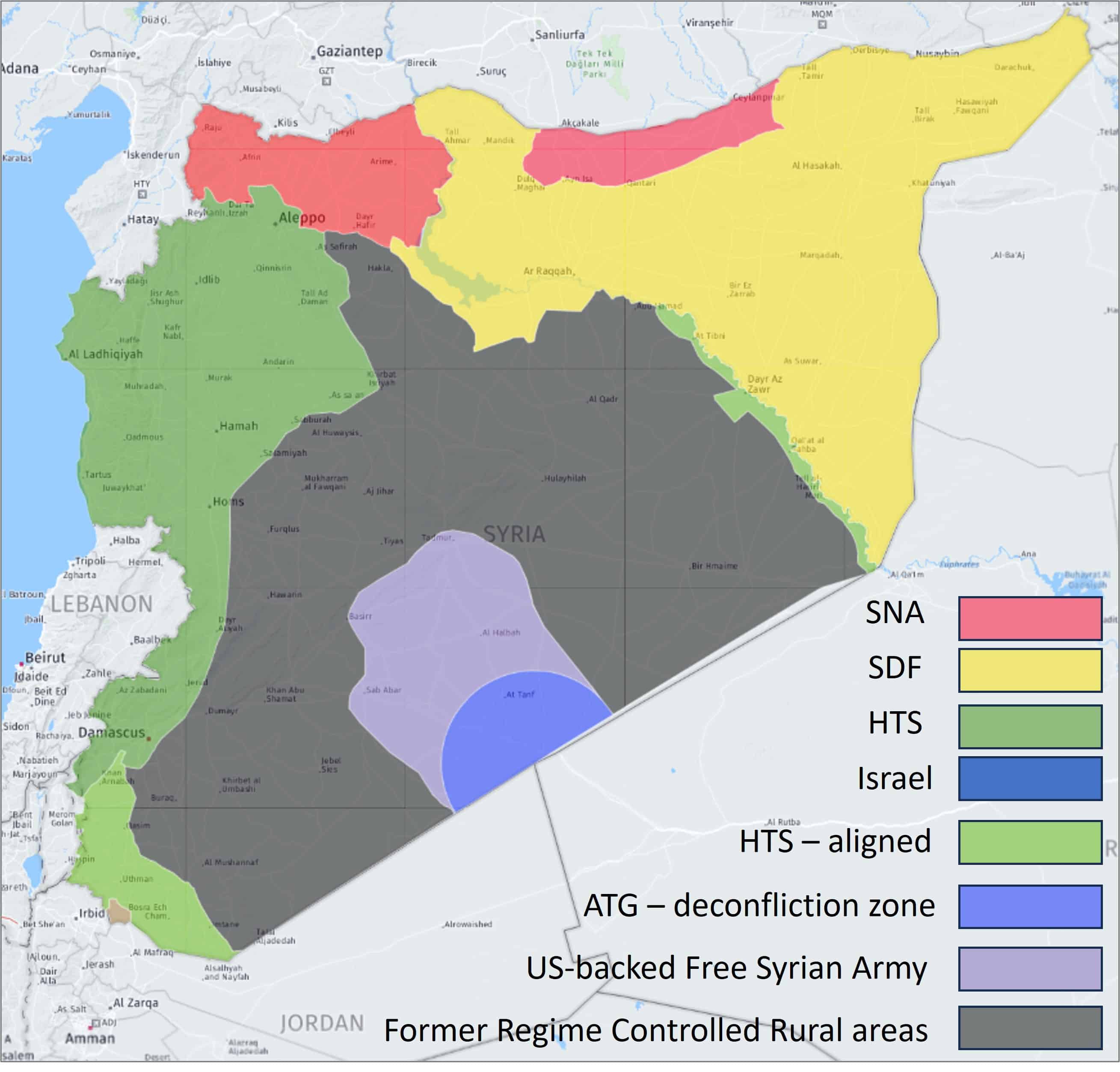NATIONAL OVERVIEW
Nationwide incidents
SIGNIFICANT EVENTS
- President Sharaa addresses start of National Dialogue Conference
- Russian Foreign Minister discussed Syria in Turkey
- Clashes between HTS and former regime-linked elements in Damascus
- HTS-linked group entered Shia shrine in Damascus
- Security operation conducted against former regime elements in Damascus city
- Protests in response to Netanyahu’s comments
- SDF claim to repulse multiple SNA-led assaults in Aleppo countryside
- Localized violence in Aleppo and Hasaka provinces
- Suspected coalition UAV strike targeted individual in eastern Aleppo province
- Kidnapping and security operation reported in Homs and Hama provinces
- Sectarian reactions to attack on MoD vehicle in Latakia
STRATEGIC AND POLITICAL DEVELOPMENTS
President al-Sharaa addresses start of National Dialogue Conference
On 25 February, representatives from across Syria arrived in Damascus to attend the much anticipated National Dialogue Conference. The first activities of the conference were held on 24 February, with an introduction session and dinner but the main event started on 25 February and was inaugurated by President Ahmed al-Sharaa and other senior members of the interim government. As predicted, President al-Sharaa struck a tone of reconciliation and spoke of the need to avoid further bloodshed, and the importance of rejecting attempts to destabilize the country’s security. President al-Sharaa also spoke of the need to turn “Syria’s calamities into investment opportunities.”

National Dialogue Conference started on 25 February
The conference will reportedly focus on six different issues in different sessions, including constitutional building, transitional justice, institutional reform, personal freedom, “human life issues” as well as the role of civil society organizations and economic issues. The start of the conference and the preparations however were met with criticism, as several attendees received very late invitations and criticism directed at holding a preparatory session lasting only one day. Several participants have also noted a lack of clarity on the agenda and criticized the government for setting the agenda without proper consultation. Lastly, several Kurdish components – most notably the Kurdish National Council – criticized the exclusion of Kurdish components as well as the “rushed” nature of its preparations. In response, members of the preparatory committee stated that Kurdish representation will come in the form of individuals rather than groups or blocs, to signal the government’s commitment to looking past ethnic and sectarian divisions.
Further details and context regarding the conference will be provided in the weekly report set for publication later on 25 February.
Russian Foreign Minister discussed Syria in Turkey
On 24 February, Russian Foreign Minister Sergei Lavrov met with his Turkish counterpart Hakan Fidan in Ankara, in a meeting that touched upon various regional issues of mutual interests. This included the situation in Syria and although few details were provided by official readouts, the Russian foreign minister expressed satisfaction with the talks and affirmed “mutual interests in stepping up joint efforts to achieve settlement based on new realities.” In a subsequent press conference, Foreign Minister Fidan’s remarks focused, as predicted, on the PKK-linked threat and he reiterated that Turkey will “not tolerate any groups seeking to carve out a presence in Syria, and we will not remain passive in addressing these threats. We expect all stakeholders to acknowledge and respect our concerns.”
The meeting follows a gradual engagement between Russia and the new Syrian government in recent weeks, which culminated with a phone conversation between President Vladimir Putin and President al-Sharaa earlier this month. Details of interactions remain limited but are in themselves significant and have prompted reports of a possible agreement to allow Russia to retain some presence in Syria moving forward. The meeting in Ankara is significant in this context as by engaging the Turkish government, Russia is likely seeking to indirectly extend its influence by focusing on mutual areas of cooperation. Whether this approach will be successful remains to be seen as the HTS and affiliated elements likely remain deeply skeptical about Russia’s engagement.
DAMASCUS & THE SOUTHERN REGION (including Suwaida, Daraa & Quneitra)
Clashes between HTS and former regime-linked elements in Damascus
At approximately midnight on 24 February, violent clashes occurred between Internal Security Forces and an armed group led by Fawzi Raya in the Qaboun and Tishreen neighborhoods of Damascus City. A member of the Internal Security Service was killed, and two others were injured in the confrontation, which involved the use of various weapons. Reports indicated a significant presence of ambulances at the scene, and multiple injuries were mentioned but remain unconfirmed. According to Damascus Governorate Security Director Lieutenant Colonel Abdul Rahman Al-Dabbagh, a security patrol in the Tishreen neighborhood of Qaboun was attacked by an armed group affiliated with remnants of the former regime. The attack resulted in one patrol member’s death and two others being injured. Security forces later reinforced the patrol, engaged in clashes with the group, and arrested its members, including their leader, Fawzi Laila, a former military security officer. The detainees were referred to the judiciary.
The incident represents a rare but not unprecedented case of former regime elements engaging in violent acts of resistance against the governments. While similar incidents have been frequently reported in Latakia, Tartous, Homs, and other provinces, attacks in Damascus have been few yet the latest incident underscores the persistent presence of anti-government elements and related tensions in the city. A heightened security posture can be expected in the affected areas in the coming days.
Security operation conducted against former regime elements in Damascus city
In a related development on the afternoon of 25 February, local sources reported that the Public Security Service carried out a security operation in the Tishreen area of the Qaboun neighborhood in Damascus. The operation targeted remnants of former regime elements suspected of involvement in clashes with security forces in the area earlier. Heightened security measures can be anticipated along Highway 6 in northern Damascus City.
HTS-linked group entered Shia shrine
In another noteworthy incident, the Syrian Observatory for Human Rights reported that an armed group stormed the Sayyida Zainab shrine in the Damascus countryside and entered its administrative offices. The same reports stated that the responsible elements were led by Wissam Mortada, who is reportedly working with the Hayat Tahrir al-Sham (HTS) military leadership. The motive was not specified and no further developments were noted, yet the significance of the Shrine for Syria’s Shia minority implies a likely sectarian motivation. Additional details will be provided as available.
Protests in response to Netanyahu’s comments
Multiple demonstrations were, as expected, reported in Damascus and the southern region in response to comments made by Israeli Prime Minister Benjamin Netanyahu on 23 February. To recall, Netanyahu stated that Israel would not allow the presence of the Syrian army or the HTS in areas south of Damascus, prompting strong reactions and calls for demonstrations on the same day. In Damascus, people gathered on the Hijaz Square, to denounce the comments and also to demand the expulsion of an Israeli journalist.
In Daraa province, gatherings were reported in the towns of Jbab, Inkhil, Kharbat Ghazalah, Harak and Kafr Shams. Similarly, multiple demonstrations were recorded in Quneitra City, Khan Arnabah and in As Suwayda. All unfolded peacefully but calls for additional demonstrations in the coming days continue to circulate in response to Netanyahu’s remarks which are expected to remain a source of tension, particularly in the southern provinces.
Limited reports of family dispute and border clashes in Daraa province
Additional noteworthy activity in the southern region included reports of armed clashes and tensions near the border in Daraa province. On the evening of 24 February, social media sources reported that an armed conflict erupted between two families in Kaheel village, resulting in one person being wounded. Security forces responded by deploying units at the village’s entrances and exits. Separately, limited and still unconfirmed reports discussed the outbreak of clashes between criminal elements and security forces in southern Daraa province, near the Syria-Jordanian border. No further details were provided and so far the clashes have not been widely reported.
NORTH & EAST SYRIA (Including Hasaka, Deir Ez Zour, Aleppo & Raqqa provinces)
SDF claim to repulse multiple SNA-led assaults in Aleppo countryside
No significant changes along the territorial control of terrain were noted in eastern Aleppo province, where daily airstrikes, artillery operations and ground clashes continue to be reported within established conflict areas. Over the review period, additional Turkish airstrikes were reported in the vicinity of Sarrin and Mount Alloush near Kobani, while high activity levels were noted in the vicinity of the Qara Qozk bridge. According to local sources, the strikes caused material damages but no casualties were discussed initially.
Meanwhile, the SDF claimed to have repulsed multiple engagements and assaults by the Turkish-backed Syrian National Army (SNA) on 24 February. This included operations, supported by Turkish UAV and airstrike operations, near Qara Qozak Bridge as well as along the Deir Hafer front. Additional engagements were also reported near the town of Shuyukh, with casualties reported on the SNA side as per SDF-linked reporting. The same reports claimed the SNA conducted artillery strikes against several villages on 24 February, including Tina, J’ada, Bir Hassou, Ghasشq, Dikan, Malha, Al-Sana’a, Saifi, and Qara Qozak – resulting in material damages to residences and other properties, but no damages discussed.
Suspected coalition UAV strike targeted individual in eastern Aleppo province
On the afternoon of 25 February, a UAV strike targeted a person riding a motorcycle on the outskirts of the village of Nasr al-Khairiya, Jarabulus district, eastern Aleppo province, killing him. According to the SOHR report, the targeted person was living in the Aleppo countryside within the areas controlled by the Syrian National Army. The identity of the target remains unclear but local reports stated the UAV strike was conducted by the international coalition, indicating that it likely targeted an individual affiliated with IS and another Islamic extremist group. Further details will be provided as available.
Localized violence in Aleppo and Hasaka provinces
Other noteworthy activity in the central region included reports of localized violence in Aleppo and Hasaka provinces. In Aleppo, a young man was shot and killed by unknown gunmen in a tinted car in the Haritan area of the Aleppo countryside. The attackers opened fire on him before fleeing and the incident appears linked to a personal dispute.
Separately, On 24 February, unknown gunmen attacked a citizen’s house near Judi roundabout in Hasaka City using hand grenades in an apparent assassination attempt. No casualties were reported and the attack is likewise believed to be related to a local issue.
CENTRAL REGION (Including Idlib, Hama, Latakia, Tartous, Hama & Homs)
Kidnapping and security operation reported in Homs and Hama provinces
Local violence was also reported in Homs and Hama provinces, in what was otherwise a subdued reporting period. In Homs city, local sources stated that a young man was kidnapped from his workplace in the Adawiya neighborhood of Homs City. A gunman wearing a military uniform entered his place of work and fired into the air to deter any intervention. Hours later, a security patrol arrived at the scene and took the kidnapped man’s car, which had been parked there. Further details were not provided, but local reports state that the victim is accused of having ties with the former regime.
A noteworthy criminally-motivated incident was also recorded in Homs province. On 24 February, social media sources reported that an armed group of four individuals stormed a house in Haik village, robbing the occupants at gunpoint. The victims, a man, his wife, and their children, were forced to hand over 60 million SYP, gold jewelry, and three cell phones. The assailants used sectarian insults and threats but ultimately spared the family’s lives after they pleaded for mercy, as per local source reporting.
Meanwhile, in Hama province, reports of security operations linked to ongoing law enforcement activities continue. According to security sources, the Internal Security Service conducted a security operation in the village of Nisaf in the Masyaf area, resulting in the arrest of several wanted individuals. Reports indicated that some villagers attempted to block the road and resist security forces during the operation, resulting in tensions but no violence. Authorities stated that arrests would continue against individuals refusing to settle their status, setting conditions for continuing hostilities linked to the resettlement process.
Sectarian reactions to attack on MoD vehicle in Latakia
In Latakia, sectarian tensions escalated somewhat following an armed attack targeting a Ministry of Defence vehicle reported on 23 February (discussed in the previous edition of the Syria Daily report). After midnight on 24 February, dozens of young men gathered in front of the police headquarters building to denounce the incident. The demonstrators notably chanted sectarian slogans and accused members of the Alawite sect of being responsible for the incident. No further developments were noted, but the incident illustrates again the persistence of sectarian hostilities in the province which is strongly associated with former regime support. Similar incidents can be expected in the short to medium term, raising the outlook for an increase in politically-motivated tensions.


